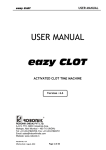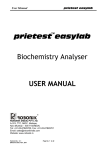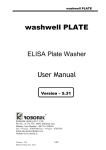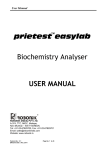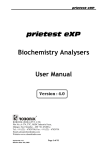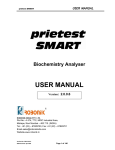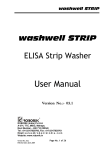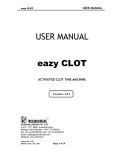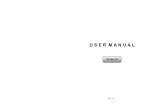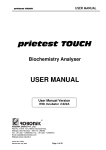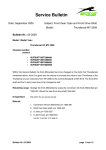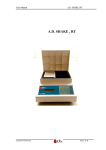Download prietest ECO - Robonik India.in
Transcript
prietest ECO prietest ECO Biochemistry Analyser USER MANUAL ROBONIK (India) Pvt Ltd. A-374, TTC, MIDC, Mahape, Navi Mumbai – 400 710(INDIA) Tel: +91-22-67829700, Fax: +91-22-67829701 Email: s a l e s @ r o b o n i k i n d i a. c o m Website: www.robonik.in Version No.: 01 Effective Date: Dec, 2008 Page No. 1 to 46 prietest ECO TABLE OF CONTENTS 1. GENERAL INFORMATION .............................................................................5 1.1. W ARRANTY INFORMATION:.............................................................................5 1.2. TECHNICAL SERVICE: ....................................................................................5 1.3. DISPOSAL INSTRUCTION:................................................................................5 1.4. CONTACTS: ..................................................................................................5 2. GENERAL SAFETY WARNINGS ...................................................................6 2.1. DANGER – WARNINGS SYMBOLS: ....................................................................6 2.2. USE OF THE INSTRUMENT:..............................................................................7 3. INTRODUCTION...............................................................................................8 3.1. DESCRIPTION:...............................................................................................8 3.2. SPECIAL FEATURES:......................................................................................8 3.3. SPECIFICATIONS: ..........................................................................................9 4. PACKING, TRANSPORT AND STORAGE ..................................................10 4.1. GENERAL WARNINGS: ..................................................................................10 4.2. PACKING: ...................................................................................................10 4.3. INSTRUMENT TRANSPORTATION:...................................................................10 4.4. STORAGE OF THE INSTRUMENT:....................................................................10 5. INSTRUMENT DESCRIPTION ....................................................................11 5.1. PERSPECTIVE VIEW :....................................................................................11 5.2. INSTRUMENT WORKING PRINCIPLE: ...............................................................12 6. INSTALLATION PROCEDURE AND VERIFICATION CRITERIA ......13 6.1. UNPACKING INSTRUCTIONS: .........................................................................13 6.2. PLACING THE INSTRUMENT:..........................................................................13 6.3. POWER SUPPLY REQUIREMENTS:..................................................................13 6.4. PROTECTIVE GROUNDING: ...........................................................................13 6.5. THERMAL PRINTER: .....................................................................................13 6.6. START UP INSTRUCTIONS:............................................................................14 6.7. PRINTER SETTING OPERATIONS: ...................................................................15 6.8. KEYBOARD CHECK:......................................................................................15 6.9. SETTING DATE AND TIME: ............................................................................15 6.10. TO ENTER CLINIC NAME: ...........................................................................16 6.11. CUVETTE INSERTION PROCEDURE:..............................................................16 6.12. CHECK LAMP AMPLITUDE:...........................................................................17 6.13. TEMPERATURE CHECK: ..............................................................................17 6.14. READINGS CHECK: ....................................................................................17 7. PRECAUTIONS................................................................................................18 Version No.: 01 Effective Date: Dec, 2008 Page No. 2 to 46 prietest ECO 8. GENERAL KEY OPERATION........................................................................19 8.1. FUNC KEY:...............................................................................................19 8.1.1. Setting Date and Time: ..................................................................................................................... 20 8.1.2. Saving Test:....................................................................................................................................... 20 8.1.3. Deleting test:..................................................................................................................................... 20 8.1.4. To Set Printer:................................................................................................................................... 21 8.2. MENU KEY:.................................................................................................21 8.2.1. Listing of saved test: ......................................................................................................................... 21 8.2.2. a) Recalling of Saved Test in Standard Mode:.................................................................................. 21 8.2.2. b) Recalling of Saved Test in Factor Mode: ..................................................................................... 22 8.2.3. To Enter Clinic Name: ...................................................................................................................... 22 8.2.4. Deleting all Tests: ............................................................................................................................. 22 8.2.5. QC Recall: ........................................................................................................................................ 23 8.3. TEMP KEY:................................................................................................24 8.4. LAMP KEY:................................................................................................24 8.5. CLEAR KEY:..............................................................................................24 8.6. ENTER KEY: .............................................................................................24 9. GENERAL FUNCTIONS .................................................................................25 9.1. SELECTING PRIMARY AND SECONDARY FILTERS: ...........................................25 9.2. SELECTION OF STANDARD OR FACTOR: ........................................................26 9.3. UNITS: .......................................................................................................26 9.4. NORMAL VALUE SELECTION: ........................................................................27 9.5. QC RANGE SELECTION: ..............................................................................27 9.6. BASE LINE REFERENCING:............................................................................27 10. PROGRAMMING MODE..............................................................................28 10.1. ABSORBANCE: ..........................................................................................28 10.2. END POINT: ..............................................................................................29 10.3. KINETIC RATE MODE: ................................................................................31 10.4. FIXED TIME MODE:....................................................................................34 10.5. DIFFERENTIAL MODE: ................................................................................37 10.6. RATIO MODE: ...........................................................................................39 10.7. PROTHROMBIN TIME MODE: .......................................................................41 10.8. MULTI STANDARD MODE:...........................................................................42 11. TROUBLE SHOOTING ................................................................................44 12. DECONTAMINATION .................................................................................45 12.1. DECONTAMINATION PROCEDURE: ...............................................................45 12.2. PURPOSE OF DECONTAMINATION: ..............................................................45 12.3. GENERAL CONSIDERATIONS:......................................................................45 12.4. PROCEDURE: ............................................................................................45 13. SAFETY CLEARANCE CERTIFICATE:.....................................................46 Version No.: 01 Effective Date: Dec, 2008 Page No. 3 to 46 prietest ECO The contents of this manual with all figures, tables and graphics are intellectual property of ROBONIK (INDIA) PVT. LTD. Unauthorized commercial or noncommercial excerption or copying of contents and use of this manual (in total or in parts) are strictly forbidden unless the editor gives written permission for it. prietest ECO manual was written and produced with the utmost care. However, errors cannot be fully excluded. Robonik does not take any responsibility and accepts no liabilities of any kind that may occur because of errors in the manual. Manufacturer: ROBONIK (INDIA) PVT LTD A-374, TTC, MIDC, Mahape Navi Mumbai 400710 (INDIA) Tel: +91-22-67829700, Fax: +91-22-67829701 Email: s a l e s @ r o b o n i k i n d i a . c o m Website: w w w . r o b o n i k . i n prietest ECO , Version -01 Version No.: 01 Effective Date: Dec, 2008 Page No. 4 to 46 prietest ECO 1. GENERAL INFORMATION 1.1. Warranty Information: Each Instrument is completely tested and guaranteed for twelve months from delivery. The warranty applies to all the mechanical and electrical parts. It is valid only for proper installation, use, and maintenance in compliance with the instructions given in this manual. ROBONIK will at its discretion repair or replace parts, which may be found defective in the warranty period. The warranty does not include any responsibility for direct or indirect personal and/or material damages, caused by improper use or maintenance of the instrument. Parts that are inherently subject to deterioration are excluded from the warranty. In case of defects due to misuse of the instrument, any incidental expenses like travel and man-hour service charges will be charged extra. 1.2. Technical Service: ROBONIK is always accessible to the customers for any kind of information about installation, use, maintenance, etc. While asking for service, please refer to this manual, and report the printed serial no. on the identification label. Only qualified technicians are entitled to fix the instrument; the user, as manual, should carry out ordinary maintenance. described in this ROBONIK’s technical service or an authorized service center with specialized technicians, with suitable instrumentation and original spare parts are always available for extraordinary maintenance (repair), under a yearly maintenance contract or on specific demand. 1.3. Disposal instruction: In case of removal or disposal of instrument, following instructions need to be followed • • Do not dispose in municipal waste; follow local regulations for instrument disposal. Plastic parts, Electronic PCBs and components can be recycled, so return back the instrument to manufacturer. 1.4. Contacts: Manufacturer: European Authorized Representative ROBONIK (INDIA) PVT LTD A-374, TTC, MIDC Industrial Area, MAHAPE, NAVI MUMBAI –400710 INDIA Obelis s.a 34, Av. de Tervuren, bte 44 B-1040 Brussels, BELGIUM Tel: (32) 2. 732.59.54 Fax: (32) 2.732.60.03 E-Mail : [email protected] Tel: +91-22-67829700, Fax: +91-22-67829701 Email: [email protected] Website: www.robonik.in Version No.: 01 Effective Date: Dec, 2008 Page No. 5 to 46 prietest ECO 2. GENERAL SAFETY WARNINGS 2.1. Danger – warnings symbols: The following symbols are used to inform the user of the safety rules. This symbol indicates generic danger. It means that, serious damage can occur to the operator if described precautions are not observed. This symbol indicates HIGH ELECTRIC VOLTAGE. It is dangerous to touch any part having this label. Only qualified operators can access these components, after unplugging the instrument from the Supply. This symbol indicates that the instrument involves the handling of samples, which can be infected (urine or human serum). In this condition, infection or contamination might occur. Pay attention to the general safety warnings when in presence of such biological substances. Use Protective clothes, gloves and glasses. This symbol in the user manual indicates that damages to the instrument or erroneous results could occur if the given warnings are not followed. This symbol indicates a portion, which is particularly important, and should be studied carefully. This symbol indicates a Protective Earth or Ground terminal. General Symbols Symbol for “Manufacturer” Symbol for “ IN VITRO DIAGNOSTIC MEDICAL DEVICE” Symbol for “AUTHORISED REPRESENTATIVE IN THE EUROPEAN COMMUNITY” Version No.: 01 Effective Date: Dec, 2008 Page No. 6 to 46 prietest ECO 2.2. Use of the instrument: The instrument has to be used for the designed purposes under specified conditions, following proper procedures and safety rules, by qualified personnel. THIS MANUAL CONTAINS INSTRUCTIONS QUALIFIED PERSONNEL ONLY. FOR OPERATION BY A qualified user has to make sure that the environmental condition is suitable, the installation is correct, the use and maintenance are proper, according to the general safety rules as well as to the particular precautions described in the manual (However, the user is not entitled to repair the instrument). A qualified technician is entitled to maintain and fix the instrument, according to the instructions given, using the original spare parts. Maintain room temperature and humidity as specified in the manual. The instrument has to be used as described in this manual. If it is not use the protection provided by the instrument may be impaired. Alterations to the instrument are strictly prohibited. The user is liable and solely responsible for any improper modification to the instrument, and for the consequences derived as a result. Should the instrument need extraordinary maintenance, contact ROBONIK service or an authorized service center. Specialized technicians, who will be able to repair the instrument using original spare parts, will carry out the maintenance. This IVD equipment complies with the emission and immunity requirements as per IEC61326 series. Warning : This equipment has been designed and tested to CISPER11 Class A. In a domestic environment it may cause radio interference, in which case, you may need to take measures to mitigate the interference." An advisory that the electromagnetic environment should be evaluated prior to operation of the device. Warning : Do not use this device in close proximity to sources of strong electromagnetic radiation (e.g. unshielded international RF sources), as these may interfere with the proper operation. Version No.: 01 Effective Date: Dec, 2008 Page No. 7 to 46 prietest ECO 3. INTRODUCTION 3.1. Description: prietest ECO is a programmable Biochemistry analyzer. It measures the optical densities of samples and it uses algorithm to calculate results, which are used for biochemical investigations. It has a user friendly program and capacity of storing programmed analytical methods and QC results. It is intended for in vitro diagnostic use. 3.2. Special Features: Effective temperature regulation system for 12 position dry block incubator. Peltier controlled Cuvette block Versatile calculation option by factor or standard concentration. Extensive programming modes. Latest technology with battery back up for 100 test, calibration graph and 10 QC results per test. Robust in built 20 Column Thermal Printer with 384 stationary heads. Unique circuitry for long lamp life. 500 µl Cuvette volume Built in stabiliser Ability to run multi standard in all modes QC with Levey-Jennings Graph Version No.: 01 Effective Date: Dec, 2008 Page No. 8 to 46 prietest ECO 3.3. Specifications: Linear measurement range Photometric Accuracy Drift Photometric Linearity Optical measurement Filters Type of filter Wave Length Half Bandwidth Filter Selection Cuvette Volume Temperature of cuvette Block Method Temperature Dry Block Incubator Number of cuvettes Temperature Light Source Warm up time Display Printer Memory Analysis Mode Concentration Calculation RS232 Serial port Power Wattage Voltage Operating Position Operating Conditions Temperature Relative Humidity Storage Conditions Temperature Relative Humidity Enclosure Size (cm) Weight (Approx) Version No.: 01 Effective Date: Dec, 2008 0.000 to 3.000 Absorbance Units (A). ± 2 % or 0.007 whichever is higher , from 0 to 1.5 A ± 3 % from 1.5 A to 3.0 A <0.007 A/hr 2.2 A Photodiode Interference 340, 405, 510, 546, 578 and 630 nm & Two Optional 10nm ± 2nm Automatic by Stepper Motor 500 µl By Peltier Control 370 C 12 Cuvettes 370 C Tungsten Halogen, 6 V / 10 W 90 Sec Four Line LCD, back lit, 4 X 20 Characters Built – in thermal printer 20 columns 32 KB Non volatile RAM Battery backup, 100 Open tests, with 10 QC results/test Absorbance Fixed Time End Point Kinetic Multi-Standard Differential Ratio PTT By factor or by Standard 2400 baud, 1 start, 8 data, 1 stop, no parity bits 50 Watts 115 – 230 Volts ± 10%, 50/60 Hz On horizontal flat, rigid & vibration free surface From + 180 C to 350 C Up to 85 % From – 100 C to 500 C Up to 85 % ABS Fire retardant 30 X 38 X 13.5 ( l X b X s ) 5 Kgs. Page No. 9 to 46 prietest ECO 4. PACKING, TRANSPORT AND STORAGE 4.1. General warnings: Instrument has transportation. to be decontaminated before packing for 4.2. Packing: Packaging is needed whenever it is to be transported or shipped by courier or other means. To pack the instrument follow the instructions as below described: Decontaminate the instrument as explained in chapter No. 13 (Decontamination) of this manual. Place the instrument into the original packaging box; Instrument has to be properly protected by plastic protective material. Put copy of safety clearance certificate (copy of Safety Clearance certificate is attached at the end of this manual) Mark the package with address, instrument identification and warning Labels. 4.3. Instrument transportation: The transportation of the instrument in unpacked condition must be limited within the room where it is used, to avoid damage. 4.4. Storage of the instrument: Before storing the instrument for a long period, pack it carefully as described above and store indoors. Relative humidity has to be less than 85%, and temperature between 0ºc and 50ºc. Version No.: 01 Effective Date: Dec, 2008 Page No. 10 to 46 prietest ECO 5. INSTRUMENT DESCRIPTION Components of different views of the below pictured instrument: 5.1. Perspective View: A) Front view Incubator Printer Cuvette Keypad Display B) Keyboard: C) Rear View RS232 Contrast Power Supply Version No.: 01 Effective Date: Dec, 2008 Page No. 11 to 46 prietest ECO 5.2. Instrument working principle: Instrument functional sequence: • • • • Switch on and program the instrument Start the test The measures and the calculations are carried out according to the assay method At the end of the cycle the results are printable and at the same time they are available at the RS232 serial port output. The diagram representing the main functional elements of the instrument. 1 2 3 4 5 AMPLIFIER 1 LAMP RS232 2 LENS 3 INTERFERENTIAL FILTERS VOLTAGE – FREQUENCY CONVERTER 4 CUVETTE PRINTER KEYPAD 5 PHOTODETECTOR MEMORY MICROPROCESSOR DISPLAY White light produced by the lamp is focused into a beam by the lens. It is passed through the Interference filter to get monochromatic light. This further passes through the sample. Part of the light is absorbed by the sample, the remaining light is transmitted. The transmitted light is focused onto the photodiode. The photodiode converts the received light in to an electrical signal that is transformed into digital form, from which the microprocessor calculates the optical density, taking in account of the blank and bichromatic selection. Version No.: 01 Effective Date: Dec, 2008 Page No. 12 to 46 prietest ECO 6. Installation procedure and verification criteria 6.1. Unpacking instructions: Check accessories as per packing list Kindly store all packing materials so as to use it to repack and ship for maintenance or servicing. 6.2. Placing the instrument: • • • The instrument has to be placed on a level bench. Room temperature has to be between 10 and 35ºC with a relative humidity below 85%. Protect it from direct sunshine 6.3. Power supply requirements: Once the instrument has been placed, plug it into a power source by the locally available approved plug-in cable. Power cord should be CE, CSA, and UL marked. 115 - 230 Volts ± 10V, 50-60 Hz 6.4. Protective Grounding: Warning: Please make sure that electrical power source is properly grounded. 6.5. Thermal printer: Internal Printer (Thermal Printer) prietest ECO comes with a built in 20 column Thermal Printer. User has to take proper care to handle this delicate instrument. TIPS FOR CAREFUL USAGE OF PRINTER Do not pull the paper when loaded 1. Lift the paper lever carefully and load the paper 2. Keep the instrument clean and dust free prietest ECO gives line feed automatically wherever it is necessary for clear reading like a. While powering on b. In between character lines User may operate the instrument by disabling the printer from the utilities menu. Version No.: 01 Effective Date: Dec, 2008 Page No. 13 to 46 prietest ECO How to insert the paper Insert the thermal paper roll by placing the sensitive side facing down. The sensitive paper side is recognizable by its smoother face. Before inserting the paper After inserting the paper 6.6. Start up Instructions: • Switch on the instrument. The instrument will display the model name • The instrument initializes all the parameters internally, and carries out a power on self-test. It then displays ‘model name “and the time indicating that initialization is complete. If a printer is enabled, model name, the time, and the date will be printed. • If the correct date and time are not displayed, switch off the instrument and switch on again. • Once initialization is over, a lamp located within the instrument will glow. This lamp requires 90 seconds for stabilization. The instrument is now in IDLE mode, and ready for use. Version No.: 01 Effective Date: Dec, 2008 Page No. 14 to 46 prietest ECO 6.7. Printer setting operations: Press MENU key under Programming Mode. In case of any problems in thermal printer, following message will displayed “SET PRINTER PR ENTER” “SKIP PRINTER PR YES” User may operate the instrument by disable the printer. To Set Printer Press FUNC key Delete test Y/N Press NO key Set time Y/N Press NO key Set printer Y/N Press YES key Printer on? Y/N Press NO key to switch off the printer, press YES key to switch On the printer 6.8. Keyboard check: Check key board by pressing MENU key first and all other keys later, one should get a beep and either alpha numerical or numerical should appear on display 6.9. Setting Date and Time: Setting of date and time can be done with the help of FUNC key Press FUNC key Delete test Y/N Press NO key Set time Y/N Press YES key The instrument displays DATE DD.MM.YY Enter date month and year in the same format Press ENTER key The instrument displays TIME HH.MM.SS Enter hour, minutes, and seconds in 24 hr format. Press ENTER key The instrument goes back to idle position Version No.: 01 Effective Date: Dec, 2008 Page No. 15 to 46 prietest ECO 6.10. To Enter Clinic Name: Press MENU Key Choose Test Enter 205 press ENTER Key Clinic Name Y/N Press YES key ABCDEFGHIJKLMN Select the characters using arrow keys, key no 4 and 6, confirm by pressing ENTER on blinking character. Conclude by pressing ENTER key twice at the last character, a maximum number of 15 characters can be entered. 6.11. Cuvette insertion procedure: Optical path direction is as shown in the diagram below; Cuvette should be inserted with V notch facing the operator. Cuvette Light path Front View Section Version No.: 01 Effective Date: Dec, 2008 Page No. 16 to 46 prietest ECO 6.12. Check lamp amplitude: Press MENU key CHOOSE TEST Press 201 and press ENTER key. The instrument shall print lamp amplitude in the following format 340 Amplitude 405 Amplitude 545 Amplitude 510 Amplitude 578 Amplitude 630 Amplitude The amplitude should be in the range of 3.000 to 11.000 without cuvette. After printing amplitude press FUNC key once the instrument shall display SAVE TEST Y/N. press CLEAR key twice to go back to idle position. 6.13. Temperature check: Press TEMP key the shall display the set temperature on display, by default set temperature is 37 degree centigrade. 6.14. Readings check: Checking of readings should be done through controls. Reading should be with range specified in data sheet of controls (care should be taken while preparing and pipetting controls and reagents, reagent and control expiry dates need to be checked.) Version No.: 01 Effective Date: Dec, 2008 Page No. 17 to 46 prietest ECO 7. PRECAUTIONS Precautions: ♦ Keep the place dry and clean. ♦ Check all the grounding wires properly. ♦ Repeat the readings, if Absorbance is more than 2.0 A. ♦ Use original packaging for transportation. ♦ Use clean Cuvettes. Check the blank absorbance of the cuvette at regular intervals to check the absorbance of the blank cuvette. ♦ Check the temperature of cuvettes block at regular intervals especially before running kinetic and fixed time. ♦ Check the linearity of the instrument at regular intervals using standards. ♦ Do not take reading when the lid is open. ♦ Incubate the reagents at set temperature for at least 30 minutes before using ♦ Normally, avoid reading HIGH OD samples immediately after referencing. ♦ Use 1ml cuvette for Coagulation test. Version No.: 01 Effective Date: Dec, 2008 Page No. 18 to 46 prietest ECO 8. GENERAL KEY OPERATION 8.1. FUNC KEY: Idle Mode Programming Mode Save Test Y/N (Ref.8.1.2) Saving Test YES Delete Test Y/N (Ref.8.1.3) Deleting Test NO YES Set Time Y/N (Ref.8.1.1) Setting Time NO Set Printer Y/N YES (Ref.8.1.4) Setting Printer NO YES Exit Y/N Version No.: 01 Effective Date: Dec, 2008 Exits to main menu Page No. 19 to 46 prietest ECO 8.1.1. Setting Date and Time: (Please refer point No. 6.9) 8.1.2. Saving Test: To save the programmed test under any programming Mode Display How to operate Save Test Y/N Yes Name Tests Y/N Yes Press YES Key No Press YES Key to Enter Name Save Test without name Test Number will be printed on the paper ABCDEFGHIJKLMN Select Arrow Keys to select Alphabets Press Enter after selection and proceed Exit Press Enter twice after completing selection 8.1.3. Deleting test: Display How to operate Press FUNC Key Delete Test Y/N Press YES Key Yes Delete Test Enter the Test No. of the Test to be deleted Press ENTER Key Test Deleted Exit Version No.: 01 Effective Date: Dec, 2008 Page No. 20 to 46 prietest ECO 8.1.4. To Set Printer: (Please refer point No. 6.7) 8.2. Menu Key: This key is used to select the saved tests 8.2.1. Listing of saved test: Press MENU Key Choose Test Enter 202 and press Enter Test Number The Instrument will print a list of saved test 8.2.2. a) Recalling of Saved Test in Standard Mode: Press MENU Key Choose Test Enter Test Number to be recalled Store Test Y/N YES NO The Instrument will use the stored value Test will have to be run using new calibrators If QC is selected, 1st sample run, will be treated as QC value and saved under the test, QC Y/N Proceed for Reading Version No.: 01 Effective Date: Dec, 2008 Page No. 21 to 46 prietest ECO 8.2.2. b) Recalling of Saved Test in Factor Mode: Press MENU Key Choose Test Enter test number which has to be recalled and press Enter Key Stored Test Y/N Reading New test QC Y/N Proceeds For reading 8.2.3. To Enter Clinic Name: (Please refer sub point No. 6.10 of point No. 6) 8.2.4. Deleting all Tests: Press MENU Key Choose Test Enter 200 press Enter Key Erase all tests Y/N YES EXITS Version No.: 01 Effective Date: Dec, 2008 Programmed memory of all tests gets erased Page No. 22 to 46 prietest ECO 8.2.5. QC Recall: It is advisable to run Quality control at regular intervals. By analyzing the quality control graph user can determine the stability of the instrument as well as the reagents. Operation Choose Test Enter 240 to select the Quality control analysis. YES Test No Enter the test Number whose quality control data to be analyzed. Prietest ECO Prints the stored QC values on the printer Plot graph Y/N Press YES To plot Graph Example Printout: Test No 1 2 3 4 5 6 7 8 9 10 1 115.483 142.033 220.433 42.033 20.733 23.249 102.533 126.466 180.666 59.733 * * * 160 * * * * * ** Version No.: 01 Effective Date: Dec, 2008 Page No. 23 to 46 prietest ECO 8.3. TEMP Key: Display How to operate Displays the cuvette temperature and exits Press Temp Key 8.4. LAMP Key: It is a toggle key to switch the lamp on and off. 8.5. CLEAR Key: Press twice to initialize the instrument. Under data entry mode it will clear the entered data while pressing once. 8.6. ENTER Key: To complete the command / data entry. Version No.: 01 Effective Date: Dec, 2008 Page No. 24 to 46 prietest ECO 9. GENERAL FUNCTIONS 9.1. Selecting Primary and Secondary Filters: The instrument asks the operator to select the primary and secondary filters. Select the filter using identification number given below. In all modes the operation begins by asking the filter to be selected. The following 6 filters have been provided. Filter Identification Key No. 1 2 3 4 5 6 Filter Wavelength 340 nm 405 nm 510 nm 546 nm 578 nm 630 nm Operation After selecting programming mode instrument prompts for filter selection Choose Filter Enter required filter ID number and press Enter Choose Secondary Filter Press Filter ID to select Press NO key and then Enter Key for Monochromatic Reading Proceed to Next Stage Version No.: 01 Effective Date: Dec, 2008 Page No. 25 to 46 prietest ECO 9.2. Selection of Standard or Factor: Prietest ECO has the flexibility to calculate the results by 1) Standard concentration method 2) Factor Method ENTER FACTOR VALUE STANDARD Y/N NO YES Enter the number or standards required to be run. (minimum 1 m maximum 7 standard can be run) No of Cals = Cal 1 = Enter the concentration value or standard Proceed to Next Stage 9.3. Units: Units can be selected by using the corresponding number key UNIT KEY NO. 1 2 3 4 5 6 7 8 9 ─ 10 11 12 13 14 Version No.: 01 Effective Date: Dec, 2008 Unit U/L U/ml mU/ml mEq/L MIL mmo/l umo/L nmo/L % ug/mL g/dL G/L Mg/dl Ug/dl G/dl Ug/ml Page No. 26 to 46 prietest ECO 9.4. Normal Value Selection: Enter the Normal range of the test Prietest ECO calculates the results and validates with normal ranges and flags the remarks accordingly Enter Normal Value Y/N Press YES for normal range and NO to proceed YES High >= Enter High Value and press ENTER Low < Enter Low Value and press ENTER 9.5. QC Range Selection: Quality control is selected by default. Under this option only range is entered for LEVY- JENNINGS graph. With out feeding high and low QC values graphs will not be plotted Press YES to enter QC range and NO to proceed QC Y/N YES High >= Enter High Value and press ENTER NO Low < Enter Low Value and press ENTER 9.6. Base Line referencing: After the lamp warm up, instrument prompts for REFERENCE, indicates the user to remove the cuvette from optical path, if any & close lid. The instrument reads air as reference and automatically adjusts the reference. Now instrument is ready for reading samples. Version No.: 01 Effective Date: Dec, 2008 Page No. 27 to 46 prietest ECO 10. PROGRAMMING MODE 10.1. Absorbance: The instrument reads and prints the monochromatic and Bichromatic Absorbance at the user selected wavelength. OPERATION Press ABS key to enter the mode Display How to operate Choose Filter Ref. 9.1 Referencing Ref. 9.6 Read Sample Displays/Prints the Absorbance value along with Sample numbers. Continue till all samples are read. Sample Printout: ABSORBANCE Filters 340 nm 37 DEGREE S.No ABS REM CON ……………………………. S1 1.160 S2 2.173 TEST CLEARED Version No.: 01 Effective Date: Dec, 2008 Page No. 28 to 46 prietest ECO 10.2. End Point: The instrument reads absorbance of the sample and calculates concentration using fed Factor or calculates the factor from concentration of the standard. OPERATION Press END PT key to enter the mode Display How to operate Ref. 9.1 Select Filter If YES, blanking need to be done, before running Standard or Factor Blank Y/N YES NO Select Standard or Factor Ref. 9.2 Unit Selection Ref 9.3 Normal Value Selection Ref. 9.4 QC Selection Ref. 9.5 K Factor (Available only if factor is selected) Ref. 9.6 Referencing Read Blank/Standard/ Sample Version No.: 01 Effective Date: Dec, 2008 Page No. 29 to 46 prietest ECO Sample Print out: WITH FACTOR END POINT Filters 340 nm FACTOR 100.0 UNITS U/L HIGH> 300.0 LOW< 100.0 QC HIGH = 300.0 QC LOW = 100.0 S.No ABS REM CON ……………………………. BL1 0.215 0.0 S 1 0.943 LOW 94.3 S 2 1.947 NORM194.7 S 3> 3.00 HIG 349.0 TEST CLEARED WITH STANDARD END POINT Filters 340 nm CALS 200.0 UNITS U/ml HIGH> 300.0 LOW< 100.0 QC HIGH = 300.0 QC LOW = 100.0 S.No ABS REM CON ……………………………. BL1 0.210 0.0 C 1 1.961 200.0 FACTOR 101.96 S1 0.948 LOW 96.6 S2 1.965 NORM 200.3 S3> 3.00 HIG 356.0 TEST CLEARED Version No.: 01 Effective Date: Dec, 2008 Page No. 30 to 46 prietest ECO 10.3. Kinetic Rate Mode: Multiple readings (maximum 15) are taken at set temperature at regular intervals and change in absorbance per minute is calculated. Concentration / Activity of enzyme is calculated from the factor fed by the user or by using calibrator. OPERATION Press KINETIC key to enter this mode. How to operate Display Ref. 9.1 Select Filter If YES, blanking need to be done, before running Standard or Factor Blank Y/N YES NO Select Standard or Factor Ref. 9.2 Unit Selection Ref. 9.3 Normal Value Selection Ref 9.4 Select the Lag time in secs Select Corresponding Number Keys (min. 3 Seconds) Select the Total Read time In secs Select Corresponding Number Keys Ref. 9.5 QC Selection Press YES to enter Initial Absorbance and NO to proceed High Initial ABS Y/N YES Continued on next page Version No.: 01 Effective Date: Dec, 2008 Page No. 31 to 46 prietest ECO Continued from previous page High Initial OD Y/N NO YES Enter Maximum Initial Abs Low Initial OD Y/N NO Enter Maximum Initial Absorbance and press ENTER YES Enter Minimum Initial Abs Enter Minimum initial Absorbance and press ENTER EXIT Initial OD selection Max Delta/Min selection Press YES to select Delta Absorbance and NO to proceed Delta ABS Y/N YES High Delta= K Factor Enter maximum Delta and press ENTER (Available only if factor is selected) Ref. 9.6 Referencing Read Blank/Standard/ Sample - Instrument will wait till the temperature of cuvette reaches the set temperature. After this Test can be saved at any time (Ref. 8.1.2). - Instrument will read the absorbance and calculate concentration and then displays / prints in following format. Version No.: 01 Effective Date: Dec, 2008 Page No. 32 to 46 prietest ECO Sample Printout: KINETIC RATE Filters 510 nm FACTOR 100.0 UNITS mEq/L HIGH> 200.0 LOW< 100.0 LAG TIME 10 RD TIME 10 # OF RD 3 QC HIGH = 200.0 QC LOW = 100.0 HIGH INIT ABS <= I ABS = 1.000 DEL/M= 1.600 S.No ABS REM CON ……………………………. BL1 0.028 S 1 1.019 D 1B 0.171 D 1C 0.118 DELTA/MINUTE= RES 0.870 LOW 87.0 S 2 0.804 D 2B 0.330 D 2C 0.052 DELTA/MINUTE= RES 1.147 NORM 114.7 S 3 0.834 D 3B 0.501 D 3C 0.333 DELTA/MINUTE= RES 2.503 HIG 250.3 TEST CLEARED Version No.: 01 Effective Date: Dec, 2008 KINETIC RATE Filters 510 nm CAL1 150.0 UNITS MIL HIGH> 250.0 LOW< 50.0 LAG TIME 10 RD TIME 10 # OF RD 3 QC HIGH = 250.0 QC LOW = 100.0 HIGH INIT ABS <= I ABS = 2.000 DEL/M= 0.800 S.No ABS REM CON ……………………………. BL1 0.058 CALS 0.770 150.0 D 2B 0.268 D 2C 0.131 DELTA/MINUTE= HIGH DELTA CALS 1.197 150.0 FACTOR 125.26 S1 0.762 D 1B 0.336 D 1C 0.298 DELTA/MINUTE= HIGH DELTA CALS 1.902 NORM238.3 S2 0.768 D 2B 0.037 Page No. 33 to 46 prietest ECO 10.4. Fixed Time Mode: Change in absorbance of sample is taken at programmed time interval and concentration is calculated either from the factor fed by the user or using standard. OPERATION Press FXT key to enter this mode. Display How to operate Ref. 9.1 Select Filter If YES, blanking need to be done, before running Standard or Factor Blank Y/N YES NO Ref. 9.2 Select Standard or Factor Unit Selection Ref. 9.3 Normal Value Selection Ref 9.4 Select the Lag time Enter Selecting the Number Keys Select Corresponding Number Keys (min. 3 Seconds) Select the Read Interval time Ref. 9.5 QC Selection Initial OD selection Initial ABS Y/N YES YES Continued on next page Version No.: 01 Effective Date: Dec, 2008 Page No. 34 to 46 prietest ECO Continued from previous page High Initial OD Y/N NO Enter Maximum Initial Abs Low Initial OD Y/N NO Enter Maximum Initial Absorbance and press ENTER YES Enter Minimum Initial Abs Enter Minimum initial Absorbance and press ENTER EXIT Max Delta selection Press YES to select Delta Absorbance and NO to proceed Delta ABS Y/N YES High Delta= K factor Enter maximum Delta and press ENTER (Available only if factor is selected) Ref. 9.6 Referencing Read Blank/Standard/ Sample - Instrument will wait till the temperature of cuvette reaches the set temperature. After this Test can be saved at any time (Ref. 8.1.2). - Instrument will read the absorbance and calculate concentration and then displays / prints in following format. Version No.: 01 Effective Date: Dec, 2008 Page No. 35 to 46 prietest ECO Sample Print out: WITH STANDARD FIXED TIME Filters 630 nm FACTOR 100.0 UNITS mmo/L HIGH> 250.0 LOW< 50.0 LAG TIME 5 RD TIME 20 # OF RD QC HIGH = 250.0 QC LOW = 50.0 HIGH INIT ABS <= I ABS = 2.000 DELTA= 1.500 S.No ABS REM CON ……………………………. BL1 0.043 S 1 1.248 2 1.308 DELTA= RES 0.059 LOW 5.9 S 2 1.275 3 1.732 DELTA= RES 0.456 LOW 45.6 S 3 0.129 4 1.163 DELTA= RES 1.034 NORM 103.4 S 4 0.095 5 2.846 DELTA= RES 2.750 HIGH 275.0 TEST CLEARED Version No.: 01 Effective Date: Dec, 2008 WITH FACTOR FIXED TIME Filters 630 nm CAL1 50.0 UNITS umo/L HIGH> 300.0 LOW< 80.0 LAG TIME 5 RD TIME 20 # OF RD QC HIGH = 300.0 QC LOW = 100.0 HIGH INIT ABS <= I ABS = 2.000 DELTA= 2.000 S.No ABS REM CON ……………………………. BL1 0.026 CALS 1.135 50.0 1 1.311 1 DELTA= CALS 0.176 0.0 FACTOR 283.82 S 1 1.159 1 1.316 DELTA= RES 0.157 LOW 44.7 S 2 1.167 2 1.717 DELTA= RES 0.55 NORM 156.2 S 3 0.108 3 2.463 DELTA= RES 2.355 HIG668.4 Page No. 36 to 46 prietest ECO 10.5. Differential Mode: Differential of Sample and Sample Blank is taken. Concentration is calculated either from the factor fed by using standard. OPERATION Use DIFF key to enter the mode Display How to operate Ref. 9.1 Select Filter If YES, blanking need to be done, before running Standard or Factor Blank Y/N YES NO Select Standard or Factor Ref. 9.2 Unit Selection Ref. 9.3 Normal Value Selection Ref 9.4 QC Selection Ref. 9.5 K Factor (Available only if factor is selected) Ref. 9.6 Referencing Read Blank/Standard/ Sample - Instrument will wait till the temperature of cuvette reaches the set temperature. After this Test can be saved at any time (Ref. 8.1.2). - Instrument will read the absorbance and calculate concentration and then displays / prints in following format. Version No.: 01 Effective Date: Dec, 2008 Page No. 37 to 46 prietest ECO Sample Print out: DIFERENTIAL Filters340 nm FACTOR 100.0 UNITS nmo/L HIGH> 200.0 LOW< 100.0 QC HIGH = 300.0 QC LOW = 100.0 S.No ABS REM CON ……………………………. BL1 0.184 S 1 0.027 2 0.964 DIFFERENCE = RES 0.936 LOW 93.6 S 2 0.969 3 2.002 DIFFERENCE = RES 1.033 NORM 103.3 S 3 0.025 4 3.525 DIFFERENCE = RES 3.00 HIGH350.0 TEST CLEARED DIFERENTIAL Filters405 nm CAL1 150.0 UNITS nmo/L HIGH> 300.0 LOW< 100.0 QC HIGH = 300.0 QC LOW = 100.0 S.No ABS REM CON ……………………………. BL1 0.068 CALS-0.001 150.0 1 0.224 DIFFERENCE = CALS 0.225 0.0 FACTOR 664.69 S 1 0.007 1 0.508 DIFFERENCE = RES 0.501 HIG 333.3 S 2 0.446 2 0.494 RES 0.048 LOW 32.2 S 3 0.481 3 0.757 RES 0.275 NORM103.3 TEST CLEARED Version No.: 01 Effective Date: Dec, 2008 Page No. 38 to 46 prietest ECO 10.6. Ratio Mode: Ratio of sample 1 and sample 2 is taken. Concentration is calculated either from the factor fed by the user or by using standard. Display How to operate Ref. 9.1 Select Filter If YES, blanking need to be done, before running Standard or Factor Blank Y/N YES NO Select Standard or Factor Ref. 9.2 Unit Selection Ref. 9.3 Normal Value Selection Ref. 9.4 Ref. 9.5 QC Selection K Factor (Available only if factor is selected) Ref. 9.6 Referencing Read Blank/Standard/ Sample - Instrument will wait till the temperature of cuvette reaches the set temperature. After this Test can be saved at any time (Ref. 8.1.2). - Instrument will read the absorbance and calculate concentration and then displays / prints in following format. Version No.: 01 Effective Date: Dec, 2008 Page No. 39 to 46 prietest ECO Sample printout RATIO MODE Filters545 nm FACTOR 100.0 UNITS G/L HIGH> 200.0 LOW< 50.0 QC HIGH = 200.0 QC LOW = 50.0 S.No ABS REM CON ……………………………. BL1 0.031 S 1 0.464 2 0.839 RATIO = RES 0.553 NORM 55.3 S 2 1.044 3 0.457 RATIO = RES 2.283 HIGH 228.3 S 3 0.456 4 1.040 RATIO = RES 2.283 LOW 43.8 TEST CLEARED RATIO MODE Filters578 nm CAL1 200.0 UNITS mg/dl HIGH> 250.0 LOW< 100.0 QC HIGH = 250.0 QC LOW = 100.0 S.No ABS REM CON ……………………………. BL1 0.029 CAL1 1.524 200.0 1 0.790 RATIO = CALS 1.927 0.0 Version No.: 01 Effective Date: Dec, 2008 Page No. 40 to 46 prietest ECO 10.7. Prothrombin time Mode: Use 1 ml cuvette for running this test. Referencing Ref. 9.1 Mix Plasma with reagent and mix cuvette well Insert Cuvette with sample and press Enter Time is displayed in seconds Prothrombin mode procedure and precautions to be taken while testing. Please note as final reagent volume is 300 µl for Prothrombin, where as the instrument requires 500 µl minimum volume, kindly use 1 ml capacity micro cuvette for testing Please note – cuvettes provided with the instrument are of 1.5 ml capacity. Testing procedure 1. Press PTT key 2. Instrument will display close the lid and press ENTER KEY 3. Close the lid with empty cuvette slot and Press ENTER KEY 4. The instrument then displays mix sample. Press ENTER KEY 5. Insert cuvette with PTT reagent in cuvette slot, then pipette sample into the cuvette, and then Press ENTRE KEY 6. The instrument will then display prothrombin time in seconds 7. Note the time, time is also printed 8. Remove cuvette and then press ENTRE KEY. 9. The instrument then display mix sample, Press ENTER KEY 10. Repeat steps 5 to 7 read next sample. Version No.: 01 Effective Date: Dec, 2008 Page No. 41 to 46 prietest ECO 10.8. Multi Standard Mode: The instrument accepts multiple calibrators (maximum 7) and plots the Graph based on • • Best-fit method Point to point method Absorbance is plotted on Y-axis and concentration on X-axis. How to operate Press YES key to select Regression and NO key to select Point to Point NO Regression Y/N YES NO Regression Point-to-Point Y/N Select Filter Select Filter Ref. 9.1 Select Blank Select Blank No. of Cals = Enter number of calibrators to be run Minimum 2 Maximum 7 CAL # = Enter concentration of calibrators using number Keys Units Enter corresponding no. Keys using units (ref. 9.3) Normal Value Y/N Press Yes for normal value YES NO High Enter Specified Low & High Value Low Referencing Ref 9.6 READ BLANK/ CALIBRATOR SAMPLE Version No.: 01 Effective Date: Dec, 2008 Place Blank/Standard/Sample under the tube Page No. 42 to 46 prietest ECO Instrument does lamp warm up and does the baseline referencing then, blank/calibrator to be once the calibrators are read, it calculates factor from the algorithm selected. Calibrator should be read either in ascending or descending order else the instrument may reject the readings if it cannot fit a curve. Graph can be plotted. Graph may be saved or test can redone if readings are not acceptable. Readings will be displayed/printed in the following format. Version No.: 01 Effective Date: Dec, 2008 Page No. 43 to 46 prietest ECO 11. TROUBLE SHOOTING Trouble shooting: ERROR MESSAGES CORRECTIVE ACTION Memory Full If Number of saved tests exceeds 125 tests then delete the unwanted tests and save the test. Clear Cuvette This error will come in Cuvette mode while referencing. Remove the cuvette and press ENTER key. Lamp Off press Enter Incase Instrument remains idle for more than 10 minutes. The lamp is switched off automatically. Press ENTER key to proceed. “SKIP PRIN. PR.YES” “SET PRI & PR.ENT “ Refer to “Chapter 6.5 thermal printer”. Version No.: 01 Effective Date: Dec, 2008 Page No. 44 to 46 prietest ECO 12. DECONTAMINATION 12.1. Decontamination Procedure: If the instrument is to be shipped after being exposed to potentially hazardous material, it should be decontaminated. The following procedure outlines how to decontaminate the instrument before packaging and shipment. 12.2. Purpose of Decontamination: Decontamination minimizes the risk to all who come in contact with the instrument during shipping, handling, and servicing. 12.3. General Considerations: • Any laboratory instrument that has been used for clinical analysis is considered a biohazard and should be decontaminated prior to handling. Intact skin is generally considered an effective barrier against infectious Organisms; however, small abrasions and cuts may not be always visible. Prophylactic gloves must be worn when handling instruments that have not been decontaminated. Gloved hands should be considered contaminated at all times and must be kept away from eyes, mouth and nose at all times. • Mucous membranes are considered prime entry routes for infectious agents. Wear eye protection and a surgical mask when there is a possibility of aerosols. • Eating and drinking while decontaminating instruments is not advisable. 12.4. Procedure: • A solution of .5% Sodium Hypo Chlorite (NaOCL) solution (Bleach) is used. Commercial bleach is 5% NaOCL; household bleach is 3% NaOCL. When using commercial bleach, use a 10:1 mixture; if using household bleach, a 6:1 mixture is required. This is a caustic solution. It is important to wear gloves and eye protection when handling it. • Wipe down the carrier and all exposed surfaces of the unit with the bleach solution. Remove the top shroud of the instrument and wipe down the top surface of the instrument base, as well as the inside of the top shroud. • Reassemble the unit and discard the used gloves and towels. Version No.: 01 Effective Date: Dec, 2008 Page No. 45 to 46 prietest ECO 13. SAFETY CLEARANCE CERTIFICATE: Please complete all information requests on this form prior to returning the instrument to the manufacturer or your local distributor for servicing, repairs or return. Thank you for your co-operation. Customer Contact Address Position Dept Tel: Country Fax: Post Code Model No. Serial No. Accessories Returned Date of Purchase (if known) Complaint Has the equipment been exposed to any of the following: a) Blood, body fluids, pathological specimens (*delete as applicable) *YES/NO If YES, please specify b) Other Biohazard if YES, Please specify Version No.: 01 Effective Date: Dec, 2008 *YES/NO Page No. 46 to 46














































